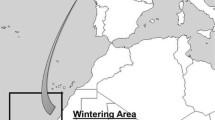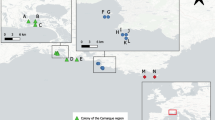Abstract
The driving factors of survival, a key demographic process, have been particularly challenging to study, especially for winter migratory species such as the Adélie penguin (Pygoscelis adeliae). While winter environmental conditions clearly influence Antarctic seabird survival, it has been unclear to which environmental features they are most likely to respond. Here, we examine the influence of environmental fluctuations, broad climatic conditions and the success of the breeding season prior to winter on annual survival of an Adélie penguin population using mark–recapture models based on penguin tag and resight data over a 16-year period. This analysis required an extension to the basic Cormack–Jolly–Seber model by incorporating age structure in recapture and survival sub-models. By including model covariates, we show that survival of older penguins is primarily related to the amount and concentration of ice present in their winter foraging grounds. In contrast, fledgling and yearling survival depended on other factors in addition to the physical marine environment and outcomes of the previous breeding season, but we were unable to determine what these were. The relationship between sea-ice and survival differed with penguin age: extensive ice during the return journey to breeding colonies was detrimental to survival for the younger penguins, whereas either too little or too much ice (between 15 and 80% cover) in the winter foraging grounds was detrimental for adults. Our results demonstrate that predictions of Adélie penguin survival can be improved by taking into account penguin age, prior breeding conditions and environmental features.





Similar content being viewed by others
References
Ainley DG (2002) The Adélie penguin - bellwether of climate change. Columbia University Press, New York
Ainley DG, DeMaster DP (1980) Survival and mortality in a population of Adélie Penguins. Ecology 61:522–530
Ainley DG, Ballard G, Karl BJ, Dugger KM (2005) Leopard seal predation rates at penguin colonies of different size. Antarct Sci 17:335–340
Ainley DG, Russell J, Jenouvrier S, Woehler E, Lyver POB, Fraser WR, Kooyman GL (2010) Antarctic penguin response to habitat change as Earth’s troposphere reaches 2C above preindustrial levels. Ecol Monogr 80:49–66
Arrigo KR, van Dijken GL, Bushinsky S (2008) Primary production in the Southern Ocean, 1997–2006. J Geophys Res 113:C08004. doi:08010.01029/02007JC004551
Ballerini T, Tavecchia G, Olmastroni S, Pezzo F, Focardi S (2009) Nonlinear effects of winter sea ice on survival probabilities of Adélie penguins. Oecologia 161:253–265
Barbraud C, Weimerskirch H, Hinke J, Bost C-A, Forcada J, Trathan PN, Ainley DG (2008) Are king penguin populations threatened by Southern Ocean warming? Proc Natl Acad Sci USA 105:E38
Burnham KP, Anderson DR (2002) Model selection and multimodel inference: a practical information-theoretic approach, 2nd edn. Springer, New York
Burnham KP, Anderson DR, White GC, Brownie C, Pollock KH (1987) Design and analysis methods for fish survival experiments based on release-recapture. Bethesda, Maryland
Cavalieri D, Parkinson C, Gloersen P, Zwally HJ (1996) Sea ice concentrations from Nimbus-7 SMMR and DMSP SSM/I passive microwave data, [1990–2007]. In. Boulder, CO, USA: National Snow and Ice Data Center
Clarke J, Kerry K (1998) Implanted transponders in penguins: implantation, reliability, and long term effects. J Field Ornithol 69:149–159
Clarke J, Kerry K, Irvine L, Phillips B (2002) Chick provisioning and breeding success of Adélie penguins at Béchervaise Island over eight successive seasons. Polar Biol 25:201–230
Clarke J, Emmerson L, Townsend A, Kerry K (2003a) Demographic characteristics of the Adélie Penguin population at Béchervaise Island after 12 years of study. CCAMLR Sci 10:53–74
Clarke J, Kerry K, Fowler C, Lawless R, Eberhard S, Murphy R (2003b) Post-fledging and winter migration of Adélie penguins Pygoscelis adeliae in the Mawson region of East Antarctica. Mar Ecol Prog Ser 248:267–278
Costa DP, Crocker DE (1996) Marine mammals of the Southern Ocean. Foundations for ecological research west of the Antarctic Peninsula. Antarct Res Ser 70:287–301
Crawley MJ (2002) Statistical computing: an introduction to data analysis using S-plus. Wiley, West Sussex
Croxall JP, Nicol SC (2004) Management of Southern Ocean fisheries: global forces and future sustainability. Antarct Sci 16:569–584
Croxall JP, Prince PA (1980) Food, feeding ecology and ecological segregation of seabirds at South Georgia. Biol J Linn Soc 14:103–131
Croxall JP, Trathan PN, Murphy EJ (2002) Environmental change and Antarctic Seabird populations. Science 297:1510–1514
Davis LS, Boersma PD, Court GS (1996) Satellite telemetry of the winter migration of Adélie penguins (Pygoscelis adeliae). Polar Biol 16:221–225
Davis LS, Harcourt RG, Bradshaw CJA (2001) The winter migration of Adelie penguins breeding in the Ross Sea sector of Antarctica. Polar Biol 24:593–597
Emmerson LM, Southwell CJ (2008) The effect of sea ice on Adelie penguin reproductive performance. Ecology 89:2096–2102
Forcada J, Trathan PN (2009) Penguin responses to climate change in the Southern Ocean. Glob Change Biol 15:1618–1630
Forcada J, Trathan PN, Reid K, Murphy EJ, Croxall JP (2006) Contrasting population changes in sympatric penguin species in association with climate warming. Glob Change Biol 12:411–423
Fraser WR, Trivelpiece WZ (1996) Factors controlling the distribution of seabirds: winter-summer heterogeneity in the distribution of Adélie penguin populations. Foundations for ecological research west of the Antarctic Peninsula. Antarct Res Ser 70:257–272
Grosbois V, Giminez O, Gaillard J-M, Pradel R, Barbraud C, Clobert J, Moller AP, Weimerskirch H (2008) Assessing the impact of climate variation on survival in vertebrate populations. Biol Rev 83:357–399
Hall-Aspland SA, Rogers TL (2004) Summer diet of leopard seals (Hydrurga leptonyx) in Prydz Bay, Eastern Antarctica. Polar Biol 27:729–734
Jarvis T, Kelly N, Kawaguchi S, van Wijk E, Nicol S (2010) Acoustic characterisation of the broad-scale distribution and abundance of Antarctic krill (Euphausia superba) off East Antarctica (30–80 E) in January–March 2006. Deep-Sea Res II doi:10.1016/j.dsr2.2008.06.013
Jenouvrier S, Barbraud C, Weimerskirch H (2006) Sea ice affects the population dynamics of Adelie penguins in Terre Adelie. Polar Biol 29:413–423
Jenouvrier S, Caswell H, Barbraud C, Holland M, Stroeve J, Weimerskirch H (2009) Demographic models and IPCC climate projections predict the decline of an emperor penguin population. Proc Natl Acad Sci USA 106:1844–1847
Kato A, Coudert YR, Naito Y (2002) Changes in Adélie penguin breeding populations in Lützow-Holm Bay, Antarctica, in relation to sea-ice conditions. Polar Biol 25:934–938
Kerry KR, Clarke JR, Else GD (1993a) Identification of sex of Adélie penguins from observation of incubation birds. Wildl Res 29:725–732
Kerry KR, Clarke JR, Else GD (1993b) The use of an automated weighing and recording system for the study of the biology of Adélie penguins (Pygoscelis adeliae). NIPR Symp Polar Biol 6:62–75
Kerry KR, Clarke JR, Else GD (1995) The foraging range of Adélie Penguins at Bechervaise Island, Mac.Robertson Land, Antarctica as determined by satellite telemetry. In: Dann P, Norman I, Reilly P (eds) The Penguins. Surrey Beatty, Australia, pp 216–243
Kerry KR, Irvine L, Beggs A, Watts J (2009) An unusual mortality event among Adélie penguins in the vicinity of Mawson Station, Antarctica. In: Kerry KR, Riddle M (eds) Health of Antarctic wildlife: a challenge for science and policy, pp 107–112
Kwok R, Comiso JC (2002) Southern ocean climate and sea ice anomalies associated with the southern oscillation. J Clim 15:487–501
Le Bohec C, Durant JM, Gauthier-Clerc M, Stenseth NC, Park Y-H, Pradel R, Grémillet D, Gendner J-P, Le Maho Y (2008) King penguin population threatened by Southern Ocean warming. Proc Natl Acad Sci USA 105:2493–2497
Lebreton J-D, Burnham KP, Clobert J, Anderson DR (1992) Modelling survival and testing biological hypotheses using marked animals: a unified approach with case studies. Ecol Monogr 62:67–118
Lefebvre W, Goosse H (2005) Influence of the Southern Annular Mode on the sea ice-ocean system: the role of the thermal and mechanical forcing. Ocean Sci 1:145–157
Lescroel A, Dugger KM, Ballard G, Ainley D (2009) Effects of individual quality, reproductive success and environmental variability on survival of a long-lived seabird. J Anim Ecol 78:798–806
Loeb V, Siegel V, Holm-Hansen O, Hewitt R, Fraser W, Trivelpiece W, Trivelpiece S (1997) Effects of sea-ice extent and krill or salp dominance on the Antarctic food web. Nature 387:897–900
Murphy EJ, Trathan PN, Watkins JL, Reid K, Meredith MP, Forcada J, Thorpe SE, Johnston NM, Rothery P (2007) Climatically driven fluctuations in Southern Ocean ecosystems. Proc R Soc Lond B 274:3057–3067
Nicol S, Pauly T, Bindoff NL, Wright S, Thiele D, Hosie G, Strutton PG, Woehler E (2000) Ocean circulation off east Antarctica affects ecosystem structure and sea-ice extent. Nature 406:504–507
Nordøy ES, Blix AS (2009) Movements and dive behaviour of two leopard seals (Hydrurga leptonix) off Queen Maud Land, Antarctica. Polar Rec 32:263–270
Parkinson CL (2002) Trends in the length of the Southern Ocean sea-ice season, 1979–1999. Ann Glaciol 34:435–440
Parkinson CL (2004) Southern Ocean sea ice and its wider linkages: insights revealed from models and observations. Antarct Sci 16:387–400
Penney RL, Lowry G (1967) Leopard seal predation on Adélie penguins. Ecology 48:879–882
SC-CAMLR (1997) CCAMLR ecosystem monitoring program: standard methods for monitoring studies. CCAMLR, Hobart
Siniff D, Stone S, Reichle D, Smith T (1980) Aspects of leopard seals (Hydrurga leptonyx) in the Antarctic pack ice. Antarct J U S 15:160–161
Smith RC, Ainley D, Baker K, Domack E, Emslie S, Fraser B, Kennett J, Leveter A, Mosley-Thompson E, Stammerjohn S, Vernet M (1999) Marine ecosystem sensitivity to climate change. Bioscience 49:393–404
Weidenmann J, Creswell KA, Mangel M (2009) Connecting recruitment of Antarctic krill and sea ice. Limnol Oceanogr 54:799–811
White GC, Burnham KP (1999) Program MARK: survival estimation from populations of marked animals. Bird Study 46(Supplement):120–139
Williams TD, Croxall JP (1990) Is chick fledging weight a good index of food availability in seabird populations. Oikos 59:414–416
Wilson D (2009) Causes and benefits of chick aggregations in penguins. Auk 126:688–693
Wilson PR, Ainley DG, Nur N, Jacobs SS, Barton KJ, Ballard G, Comiso JC (2001) Adélie Penguin population change in the Pacific sector of Antarctica: relation to sea-ice extent and the Antarctic circumpolar current. Mar Ecol Prog Ser 213:301–309
Acknowledgments
We thank the Béchervaise Island field teams, in particular Judy Clarke, Megan Tierney and Knowles Kerry who established monitoring at Béchervaise Island. Angela Bender created the maps and Ben Raymond provided daily sea-ice data. Rob Massom and Alex Fraser provided suggestions regarding sea-ice data interpretation and Mark Bravington provided statistical advice. Andy Townsend developed the database and various engineers constructed, maintained and improved detection gateways and tag readers. Steve Nicol and Jemery Day provided useful suggestions for the manuscript. This project was supported by the AAD ASAC project #2722. Attachment of electronic tags to penguins and other procedures were with approval from the Australian Antarctic Division’s Animal Ethics Committee.
Author information
Authors and Affiliations
Corresponding author
Additional information
Communicated by Markku Orell.
Rights and permissions
About this article
Cite this article
Emmerson, L., Southwell, C. Adélie penguin survival: age structure, temporal variability and environmental influences. Oecologia 167, 951–965 (2011). https://doi.org/10.1007/s00442-011-2044-7
Received:
Accepted:
Published:
Issue Date:
DOI: https://doi.org/10.1007/s00442-011-2044-7




